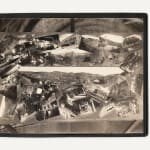Charles DeForest Curtis
Presentation Album with Mining and Town Views of Lead, South Dakota, 1903
Photo album; silver prints (12)
Each 7 1/2 x 9 1/2 inches
Each with affixed caption label on page verso; some with manuscript captions to print recto; a few with Curtis's credit in negative.
Location and date in manuscript to paper cover.
Each with affixed caption label on page verso; some with manuscript captions to print recto; a few with Curtis's credit in negative.
Location and date in manuscript to paper cover.
Further images
-
(View a larger image of thumbnail 1
)

-
(View a larger image of thumbnail 2
)

-
(View a larger image of thumbnail 3
)

-
(View a larger image of thumbnail 4
)

-
(View a larger image of thumbnail 5
)

-
(View a larger image of thumbnail 6
)

-
(View a larger image of thumbnail 7
)

-
(View a larger image of thumbnail 8
)

-
(View a larger image of thumbnail 9
)

Well-shot promotional album showing the mining town of Lead, South Dakota, in the early 20th-century, with a focus on the Homestake Mine. There are a few different photos of the...
Well-shot promotional album showing the mining town of Lead, South Dakota, in the early 20th-century, with a focus on the Homestake Mine.
There are a few different photos of the Homestake Mine, including a view of the feed floor, a shot of gold being weighed in the assay office, one of the slag floor, one of the collection house, and one of workers drilling in the mine. There is also a bird’s eye view of the eastern side of town, one of Spearfish Canyon, one showing a cut in the mountain, one of the Star Mill, and a dynamic composite photo.
From the Lead Historic Preservation Society:
“The Homestake Mine was once called the “Richest 100 Square Miles” on the Earth. The original ore body was discovered in 1876, in Bobtail Gulch south of present day Central City, by the Manuel Brothers, Fred and Moses, Hank Harney and Alexander Engh. In 1877, the original claim was sold to George Hearst, who named the claim Homestake. The Homestake Mine was in continuous operation for 126 years; over that time the miners extracted 41 million ounces of gold and 9 million ounces of silver.”
The photos were taken by local photographer Charles DeForest Curtis, who opened a photo gallery in Lead around 1901. Three years later, he was proclaiming himself to be a spiritual medium, and was institutionalized. As described in article published in the Lead Daily Pioneer-Times:
“C.D. Curtis, the photographer, who in his art is, perhaps, the best that ever struck the hills, is confined to a room in the Gordon Rooming house at No. 112 Main street, suffering with an attack of insanity (may be permanent and may be temporary) brought on by over excitement and too close to study of occultism and spiritualism. Mr. Curtis came to this city about three years ago…Since that time [he] has been in and out of the gallery, dividing his time between his profession and another profession of which he imagined he was an adept, "Spiritual Healing of the Sick." From this he went into a study of occultism and spiritualism, and for two weeks before his collapse he fasted nearly all the time, believing that was a part of the orders of the divine and unseen power.”
Curtis passed away later that year.
There are a few different photos of the Homestake Mine, including a view of the feed floor, a shot of gold being weighed in the assay office, one of the slag floor, one of the collection house, and one of workers drilling in the mine. There is also a bird’s eye view of the eastern side of town, one of Spearfish Canyon, one showing a cut in the mountain, one of the Star Mill, and a dynamic composite photo.
From the Lead Historic Preservation Society:
“The Homestake Mine was once called the “Richest 100 Square Miles” on the Earth. The original ore body was discovered in 1876, in Bobtail Gulch south of present day Central City, by the Manuel Brothers, Fred and Moses, Hank Harney and Alexander Engh. In 1877, the original claim was sold to George Hearst, who named the claim Homestake. The Homestake Mine was in continuous operation for 126 years; over that time the miners extracted 41 million ounces of gold and 9 million ounces of silver.”
The photos were taken by local photographer Charles DeForest Curtis, who opened a photo gallery in Lead around 1901. Three years later, he was proclaiming himself to be a spiritual medium, and was institutionalized. As described in article published in the Lead Daily Pioneer-Times:
“C.D. Curtis, the photographer, who in his art is, perhaps, the best that ever struck the hills, is confined to a room in the Gordon Rooming house at No. 112 Main street, suffering with an attack of insanity (may be permanent and may be temporary) brought on by over excitement and too close to study of occultism and spiritualism. Mr. Curtis came to this city about three years ago…Since that time [he] has been in and out of the gallery, dividing his time between his profession and another profession of which he imagined he was an adept, "Spiritual Healing of the Sick." From this he went into a study of occultism and spiritualism, and for two weeks before his collapse he fasted nearly all the time, believing that was a part of the orders of the divine and unseen power.”
Curtis passed away later that year.








